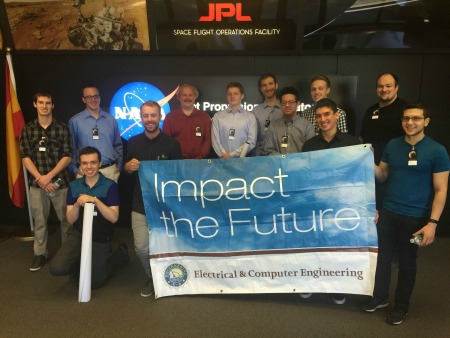
UAlberta Department of Electrical and Computer Engineering students unfurl their flag at Nasa's Jet Propulsion Lab, as invited guests to see the Rosetta spacecraft's final images.
(Edmonton) Engineering students invited to NASA's Jet Propulsion Lab last week were among the first people to see images taken by the Rosetta spacecraft as it made a planned crash on Comet 67P/Churyumov-Gerasimenko.
About a dozen students from the Department of Electrical and Computer Engineering were invited to watch the mission finale at JPL by Artur Chmielewski, a mechanical engineer and NASA's project manager of the Rosetta mission.
After delivering an engaging presentation on engineering and the Rosetta mission during a visit to the Faculty of Engineering, Chmielewski invited students to JPL to see Rosetta complete its 12-year mission.
"It was an opportunity you just could not refuse," said Carson Dick, an engineering physics student who made the trip.
Dick has a strong interest in optical engineering and is considering a graduate degree specializing in that area. He sees how his field has direct applications to space exploration.
"For me, this very much re-emphasized how one of the classic issues with astronomy is still (optical) resolution," said Dick, explaining that the comet's shape was initially determined by exploring shadows moving across its surface as it tumbled through space.
Many of the students were in elementary school when Rosetta was launched March 2, 2004. It was the first mission to land a spacecraft on a comet to collect and analyze material. After travelling 6.5 billion km Rosetta made its rendezvous with the comet in August, 2014. On November 9, 2014, it dispatched a probe, Philae, to the comet's surface.
Final manoeuvres to capture detailed images and crash Rosetta into the comet were handled in Germany-the mission was run jointly between NASA and the European Space Agency. The U of A engineering students were among about 50 VIPs in an auditorium at JPL, connecting via Skype with Chmielewski, who was in Germany.
"It felt like the closing of a very import project, and we got to be there in person as they were wrapping it up," said Dick. "Artur was joking that he has to find another job because his job is over."
Allen Elbana, who organized Chmielewski's visit to the U of A before graduating with a degree in electrical engineering in April, said the visit gave students an appreciation of how engineers and scientists work together on such projects. Just as the teams debated where to land Philae on the comet, they likewise challenged each other on where to crash Rosetta. Picking a final resting place for the spacecraft meant balancing risks of protecting instruments while getting valuable photos of dust-spewing pits on the surface.
Dyck describes the JPL mission control rooms as being "almost mystical places," you never imagine yourself setting foot in, and Elbana would agree.
"For me, one of the real highlights was walking into their Mission Control room," he said. "It was dark, with red lights and three big projection screens and different computer desks for people on different missions, and up on screens you can see commands being sent back and forth between them and Curiosity (an unmanned vehicle on Mars).
"But when I saw Voyager 2 up on the screen that was a real highlight. It left Earth in the 1970s and it's now beyond Pluto and they're still receiving information from it. Up on one of the large screens you could see what looked like a command prompt, it was either information it was receiving or sending away. It was pretty surreal."
Second-year electrical engineering student Jack Zhao said the opportunity to visit NASA and have a behind-the-scenes look at the mission makes the idea of one day being involved in space missions "more tangible."
"My goal for first couple years of engineering is that I want to have as many different and special experiences as I can," he said.
His most memorable moment was hearing discussions about future space missions and the technical demands to be overcome.
"They were speaking very specifically about mission that is going to be happening in five or 10 years-these were the seeds of something that is going to happen."
All of the students say they owe a debt of gratitude to electrical engineering professor Abdul Elezzabi, who encouraged the students to reach out to Chmielewski in the first place, and who consistently asks students to think big.
He is truly the reason this all happened-he motivated us to go down this path," said Elbana. "He spurs interest in big project like this and people in the program feel like they can achieve those things. Every time we discuss employment with him, he has always been about the mindset that biggest is better. That's his mentality and he shares that with students."